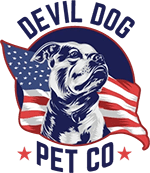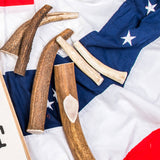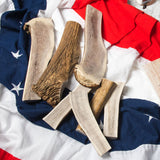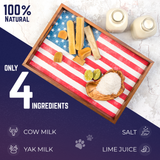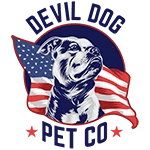Key Takeaways
- Edible dog toys provide a safe and satisfying alternative to plastic chew toys.
- Choosing the right edible toy can transform destructive chewing into purposeful enrichment.
- Intentional selection and leadership are essential when introducing edible dog toys.
- Edible dog toys promote safe and constructive chewing habits for dogs.
Table of Contents
- What Is an Edible Dog Toy?
- The Biological Why, Why Real Dogs Need to Chew
- What Makes an Edible Dog Toy Truly Safe?
- Core Types of Edible Dog Toys, Materials, Pros, Cons & Real-World Tests
- How to Choose the Right Edible Dog Toy, Extreme Leadership in Action
- Safe Supervision and Usage Techniques
- Edible vs. Non-Edible Chew Toys, Complete Analysis
- Special Considerations: Age, Allergies, and Health Needs
- The Devil Dog Standard, Uncompromising Quality
- Troubleshooting Common Edible Toy Issues
- Special Considerations: Age, Allergies, and Dietary Needs
- The Marine's Extreme Dog Leadership Implementation
- Final Recommendations and Next Steps
Edible Dog Toys, The Marine-Proven Guide to Safe, Satisfying, and Purposeful Chewing
If you'd never toss your dog a plastic bone and walk away, you're our kind of leader. The right edible dog toy transforms destructive chewing into purposeful enrichment, but only when you choose wisely and lead with intention.
For dogs who need a safe and satisfying chew, yak cheese chews offer a long-lasting, fully digestible option that supports healthy chewing habits. If your dog is a power chewer, consider the whole elk antler for maximum durability and enrichment.
What Is an Edible Dog Toy?
The Biological Why, Why Real Dogs Need to Chew

Chewing activates your dog's parasympathetic nervous system, reducing cortisol levels by up to 23% according to veterinary behavioral studies. Wild canines spend 4-6 hours daily gnawing bones, exercising jaw muscles, and scraping teeth clean.
Modern dogs retain this hardwired drive. Without appropriate outlets, they redirect chewing energy toward baseboards, shoes, and furniture. Proper edible dog toys satisfy this biological need while strengthening the jaw-to-brain connection that promotes calm focus.
Chewing is a dog's version of field maneuvers, a working mind is a well-behaved mind. Deny this outlet, and you'll manage behavioral problems instead of preventing them.
What Makes an Edible Dog Toy Truly Safe?
Five non-negotiable criteria separate safe edible dog toys from dangerous knockoffs:
Size Protocol: Choose toys longer than your dog's jaw measurement from nose tip to jaw end. Minimum safety margin prevents wedging between back molars.
Hardness Scale: Rate chews 1-10 for tooth safety. Elk antlers (10/10) suit veteran chewers; yak cheese (7/10) works for most adults; bully sticks (5/10) accommodate puppies and seniors.
Ingredient Integrity: Single or limited ingredients only. Reject anything with artificial coatings, dyes, bleach, or chemical hardeners. Human-grade starting materials ensure digestive safety.
Digestibility Standard: Veterinary-approved chews break down within 24 hours in the gut. Test by soaking a small piece in warm water, it should soften or dissolve.
Safety Check: When in doubt, size up, supervise, and ditch chews that splinter or become swallowable.
Core Types of Edible Dog Toys, Materials, Pros, Cons & Real-World Tests
Antler Chews - Ultra-Durable Champions
Best for: Power chewers who destroy everything else
Naturally shed elk antlers deliver 3-5 weeks of chew time per piece. Zero odor, hypoallergenic, and packed with calcium. Ultra-hard surface requires experienced chewers, not for puppies or dogs with dental issues.
Himalayan Yak Cheese - Balanced Performers
Best for: Most adult dogs seeking long-lasting flavor
Milk-based, fully digestible, nearly odorless. High protein content satisfies taste while lasting 1-2 weeks for moderate chewers. Rich dairy may cause loose stools initially, introduce gradually.
Bully Sticks - Quick Satisfaction
Best for: Training rewards and supervised sessions
Single-ingredient beef, completely digestible, irresistible flavor. Consumed quickly (20-60 minutes), making them ideal for timed enrichment rather than marathon chewing. For more options, explore our bully sticks collection for a variety of sizes and shapes to suit your dog's needs.
Plant-Based - Gentle Options
Best for: Senior dogs and food-restricted diets
Rice, potato, or pea protein formulations. Softer texture makes them ideal for dogs with dental sensitivity or multiple food allergies.
These chews dissolve gradually, reducing choking risk while still providing mental stimulation. Most plant-based options contain added vitamins and minerals for nutritional benefit.
How to Choose the Right Edible Dog Toy, Extreme Leadership in Action

Selecting the perfect edible dog toy requires tactical assessment, not guesswork. Follow this Marine-tested protocol:
Step 1: Assess Chewing Style and Energy
Does your dog power-gnaw like our dog Dexter, or nibble delicately? Aggressive chewers need ultra-durable antlers or Monster-sized yak chews. Gentle gnawers thrive with bully sticks or split antlers that reward patience over force.
Step 2: Size and Hardness Selection
Choose toys longer than your dog's jaw measurement, from nose tip to jaw end. For puppies under 6 months, start with split antlers or oversized yak chews, never full-strength whole antlers. Senior dogs benefit from softer yak cheese or plant-based options.
Step 3: Ingredient Panel Evaluation
Scan every label for allergens and artificial additives. Single-ingredient chews like Devil Dog's bully sticks eliminate guesswork. Avoid anything listing "by-products," chemical preservatives, or unpronounceable compounds.
Step 4: Test Drive Protocol
Start every new edible dog toy with a supervised 10-15 minute session. Watch for excessive excitement, digestive upset, or complete disinterest. Adjust size or type based on initial response before committing to longer sessions.
Safe Supervision and Usage Techniques
Responsible leadership means eyes-on management, especially during introduction phases.
First-Time Supervision Standards
New chews require full attention, leash your dog if necessary to control the interaction. Position yourself within arm's reach to intervene if rapid gulping or aggressive biting occurs. Never leave a dog unattended with an unfamiliar edible dog toy.
Trade-Out Technique Mastery
When any chew shrinks to swallowable size, execute an immediate trade. Offer a high-value treat while calmly removing the nub. For bully sticks, use chew holders to extend safe usage time and prevent choking hazards.
Session Timing and Storage
Limit initial sessions to 10 minutes, gradually extending to 20-30 minutes as tolerance builds. Store yak chews and antlers in dry conditions; freeze bully sticks between sessions to increase difficulty and longevity. Rotate chew types weekly to maintain engagement and prevent obsessive behavior.
Edible vs. Non-Edible Chew Toys, Complete Analysis
| Criteria | Edible Dog Toys | Non-Edible Chews |
|---|---|---|
| Safety Profile | Fully digestible, no blockage risk when sized correctly | Potential choking/blockage if pieces break off |
| Nutritional Value | Protein, minerals, dental benefits | Zero nutritional contribution |
| Longevity | Consumed over time, replacement needed | Indefinite if undamaged |
| Environmental Impact | Biodegradable, minimal waste | Plastic/synthetic materials persist |
| Cost Efficiency | Higher per-unit, ongoing replacement | One-time purchase, potential vet bills |
The fundamental difference: edible dog toys transform into nutrition, while non-edible options create waste or, worse, emergency vet visits. Quality edible chews eliminate microplastic concerns and provide measurable health benefits beyond simple entertainment. For more on what makes a chew truly edible for dogs, check out our in-depth guide.
Special Considerations: Age, Allergies, and Health Needs

Puppy Protocols
Introduce edible toys only after adult teeth emerge around 5-6 months. Start with split antlers or Standard bully sticks under constant supervision. Limit sessions to prevent rich protein from replacing balanced puppy food.
Senior Dog Adaptations
Older dogs with dental wear benefit from softer yak chews or plant-based options. Avoid ultra-hard antlers unless veterinarian-approved. Monitor for increased sensitivity and adjust chew hardness accordingly.
Allergy Management
Beef-sensitive dogs thrive with elk antlers or yak cheese alternatives. Multiple protein allergies require plant-based formulations. Always introduce single-ingredient options first to isolate potential reactions.
Weight Control Considerations
Factor chew calories into daily intake, a Standard bully stick contains approximately 90 calories. Limit treats to 10% of total daily calories, adjusting meal portions when providing high-calorie edible dog toys.
The Devil Dog Standard, Uncompromising Quality
Devil Dog Pet Co. champions Extreme Dog Leadership through unbreakable quality control and ethical sourcing. Every antler comes from naturally shed Rocky Mountain elk. Our yak chews undergo rigorous food-grade testing overseas and additional inspection during our in-house packaging process. Our bully sticks come from grass-fed cattle, triple-washed and extra-baked for minimal odor without compromising nutritional value.
When you choose Devil Dog Pet Co., you're supporting veteran-owned business principles and our partnership with Hounds for Heroes, providing service dogs to veterans at no cost. Every purchase reinforces our commitment to keeping dogs out of shelters through proper owner education and premium chew tools.
Troubleshooting Common Edible Toy Issues
Dog devours chews too quickly: Freeze the edible dog toy for 2-4 hours before serving to increase hardness and extend chew time. Use bully stick holders to secure the final inches safely. Rotate between different chew types to maintain novelty and prevent speed-eating habits.
Dog ignores the new chew: Rub a small amount of low-sodium broth on yak chews or warm bully sticks slightly to activate scent. Remove favorite toys temporarily to create "novelty hunger" that drives interest toward the edible option.
Digestive upset after introduction: Scale back to 10-minute supervised sessions and ensure adequate fresh water access. Rich protein from bully sticks or marrow from split antlers can cause loose stools if consumed too rapidly. Always transition gradually to new chew types.
Swallowed large chunk concerns: Monitor for signs of distress, difficulty defecating, or vomiting. Most properly sized edible dog toys break down safely, but contact your veterinarian if symptoms persist beyond 24 hours or worsen. For additional safety tips, see the American Animal Hospital Association's advice on safe chew toys for dogs.
Special Considerations: Age, Allergies, and Dietary Needs

Puppy protocols (under 6 months): Introduce only after adult teeth emerge around 4-5 months. Start with oversized split antlers or Standard bully sticks in 15-minute supervised sessions. Avoid whole antlers until jaw strength develops fully. For gentle puppies, the Extra Small Split Elk Antler Dog Chew is an excellent starter option.
Senior dog modifications: Choose softer options like yak chews or Standard bully sticks over whole antlers. Seniors with dental wear benefit from brief soaking to slightly soften the surface. Monitor gum sensitivity and adjust session length accordingly.
Allergy Management: Beef-sensitive dogs should avoid bully sticks; choose antlers or yak chews instead. Dairy-sensitive dogs should skip yak chews and opt for single-ingredient bully sticks or antlers. Always introduce new proteins gradually.
Weight management considerations: A Standard 6-inch bully stick contains approximately 90 calories, while yak chews average 3.5 calories per gram. Limit treat calories to 10% of daily intake and adjust meal portions when incorporating calorie-dense edible dog toys.
The Marine's Extreme Dog Leadership Implementation
Extreme Dog Leadership means taking full responsibility for your dog's success. Every edible dog toy becomes a leadership tool when used with intention and consistency. Establish clear chew rules: designated locations, supervised sessions, and immediate trade-outs when safety thresholds are reached.
Create a rotation schedule that prevents boredom while maintaining structure. Monday might feature a yak chew for mental stimulation, Wednesday a bully stick for protein reward, and Friday a split antler for extended engagement. This systematic approach builds anticipation and prevents resource guarding behaviors. For more creative enrichment ideas, check out our article on the fire hose dog toy for active pups.
Document your dog's responses to different chew types, noting preferences, session lengths, and any digestive reactions. This data-driven approach enables you to optimize chew selection and timing for maximum behavioral and health benefits.
Remember: your leadership determines outcomes. A properly selected and supervised edible dog toy prevents destructive chewing, reduces anxiety, and strengthens the human-dog bond through positive engagement opportunities.
Final Recommendations and Next Steps
For first-time buyers, start with Devil Dog Pet Co.'s yak chews, they offer the ideal balance of safety, longevity, and palatability across most dog types. Power chewers should graduate to Monster Himalayan Dog Chew once chewing technique is established, while gentler dogs thrive with Standard bully sticks.
Size up rather than down when uncertain. An oversized edible dog toy can be managed through supervision and timing, but an undersized chew creates immediate safety risks. Monitor the first three sessions closely, then adjust frequency and duration based on your dog's individual response patterns.
Join the Devil Dog community for ongoing support and advanced chewing strategies. Our veteran-backed approach to dog ownership provides the structure and accountability needed for long-term success. Every purchase supports our mission to keep dogs in homes and out of shelters through proper owner education.
Your dog deserves leadership that prioritizes safety, enrichment, and quality. Choose Devil Dog Pet Co. for edible dog toys that meet the highest standards, because extreme ownership demands nothing less than excellence. For additional veterinary-backed research on chewing and canine health, see this peer-reviewed study on chewing behavior in dogs.
Frequently Asked Questions
What criteria should I consider to ensure an edible dog toy is safe for my pet?
Choose an edible dog toy that’s sized larger than your dog’s jaw to prevent choking, made from digestible, non-toxic ingredients, and rated appropriately for your dog’s chewing strength. Always monitor chew hardness to protect teeth and avoid toys that splinter or break into sharp pieces. Supervision and gradual introduction are key to safety.
How do edible dog toys benefit my dog's biological need to chew compared to plastic toys?
Edible dog toys satisfy your dog’s natural chewing drive with digestible materials that promote dental health and mental engagement, unlike plastic toys which can break or cause injury. Chewing edible toys activates calming neurological pathways and helps prevent destructive behaviors by providing purposeful enrichment aligned with your dog’s instincts.
Which types of edible dog toys are best suited for power chewers versus puppies or senior dogs?
Power chewers thrive on durable options like whole elk antlers that withstand heavy gnawing, while puppies and senior dogs benefit from gentler chews such as split antlers, yak cheese chews, or standard bully sticks that are softer and easier on developing or worn teeth. Matching chew toughness to your dog’s age and jaw strength is essential.
How can I effectively supervise and introduce edible dog toys to prevent destructive chewing habits?
Start by offering the chew during short, supervised sessions to gauge your dog’s chewing style and tolerance. Use positive reinforcement for calm chewing, rotate chew types to maintain interest, and retire any toy that becomes small or damaged. Consistent leadership and monitoring turn chewing into a controlled, enriching activity rather than a destructive habit.
